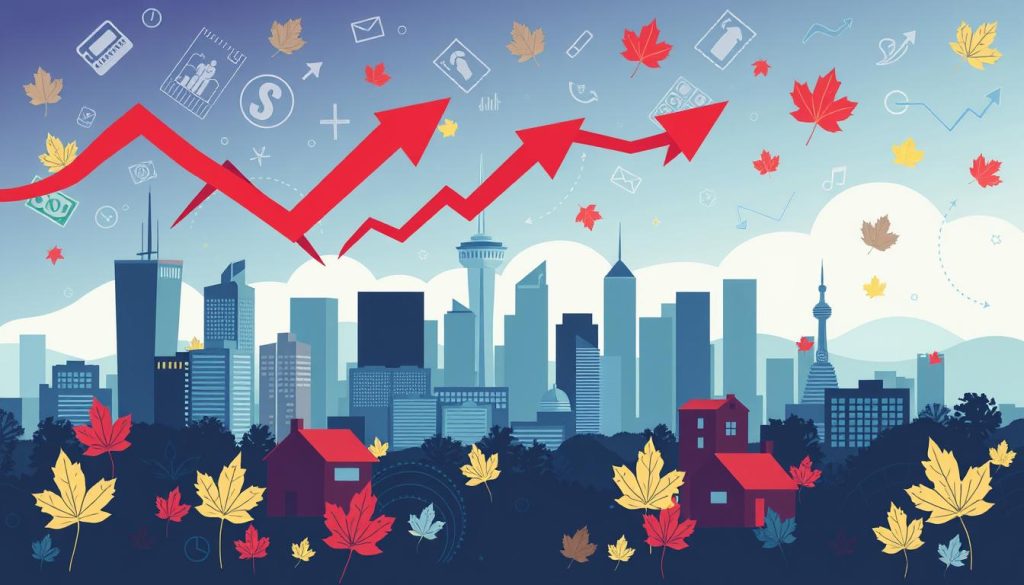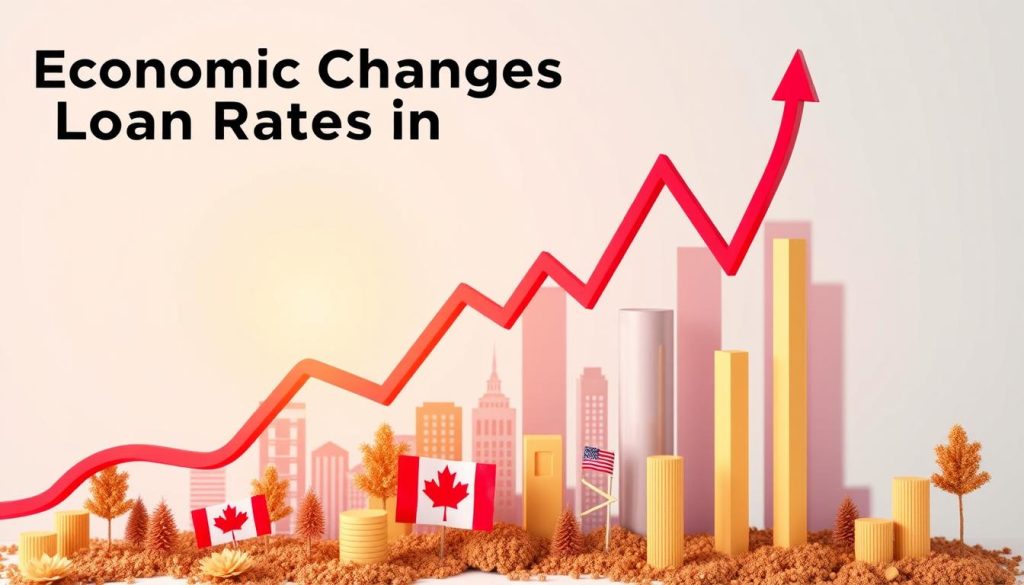Today’s economy is complex, and we see how economic changes affect loan interest rates in Canada. Factors like expansion and government strategies assume a major part in Canadian credit financing costs. It’s pivotal to stay aware of these changes.
Ongoing monetary movements, both neighborhood and worldwide, have caused credit rates to change. These changes can greatly impact what we pay when we borrow money. Realizing about these patterns assists us with pursuing better credit choices, whether for individual or business needs.

Understanding the Current Economic Landscape in Canada
To comprehend credit loan costs in Canada, we want to check the economy out. We must analyze economic indicators and loan rates. These help shape our financial world. By knowing these indicators, like GDP growth and inflation, we can guess how they affect loan rates.
Outline of Key Monetary Pointers
Numerous financial pointers show how well the economy is doing. Here are some important ones:
- Total national output (Gross domestic product) – Shows the country’s monetary development.
- Joblessness Rate – Lets us know the number of individuals that are jobless, influencing buyer certainty.
- Expansion Rate – Significant in light of the fact that it demonstrates the way that much cash can purchase, affecting loan costs.
These indicators help us understand Canadian economic trends and loan rates. They also give us clues about future interest rates in lending.
Recent Trends Affecting the Canadian Economy
Recently, we’ve seen changes in how people spend and in international trade. These changes affect our economy. Key trends include:
- Increased Consumer Spending – More spending helps GDP grow.
- Changes in Trade Relations – Deals and tariffs can impact stability.
- Technological Advancements – New tech leads to better productivity and jobs.
Watching these trends helps us understand loan rate changes in Canada. It also helps us make better financial choices.

The Impact of Economic Changes on Loan Interest Rates in Canada
Recent changes in loan interest rates show us the state of Canada’s economy. By looking at these changes, we see how different economic factors work. This includes central bank policies and what people want in the market.
Analyzing Recent Fluctuations in Loan Rates
In the last few months, loan interest rates in Canada have seen big changes. These shifts often come from the Bank of Canada’s big announcements. They affect how lenders set their rates.
When the economy is unsure, these rate changes are more noticeable. As the world’s economy changes, so do our interest rates. This makes it tricky for people taking out loans.
Economic Factors Influencing Current Interest Rates
Many economic factors affect today’s interest rates. High inflation means higher borrowing costs. Jobs and how much people spend also play a big part.
Changes in government policies can also change the economy and loan rates. By studying these factors, we can make smarter financial choices.
Factors Influencing Loan Rates in Canada
When we look at loan rates in Canada, several important factors come into play. Inflation is a big one, and so are government policies. Knowing about these helps us find better loan deals.
The Role of Inflation in Setting Loan Rates
Inflation is key in setting loan rates. It affects how much lenders charge for borrowing. When inflation goes up, money buys less, so lenders raise rates to keep profits up. This shows how inflation and loan rates are closely linked.
The Influence of Government Policies on Loan Interest Rates
Government policies also play a big role in loan rates. Economic growth plans can change lending rates. For example, stimulus plans can make borrowing cheaper or more expensive. This shows how government actions impact loan rates.
Future Predictions for Canadian Loan Interest Rates
As we move through economic changes, knowing about loan rates in Canada is key. Experts say rates might change due to economic shifts. They think rates could go up because of inflation and central bank actions.
Big banks and global forums also share their views. They tell us how global factors will affect our borrowing costs. For instance, if inflation keeps rising, interest rates might increase. This means we should get ready for possible rate hikes.
Staying updated on these trends helps us plan better. Knowing about loan rate predictions lets us make smarter borrowing choices. Watching economic signs and listening to experts is important for handling loan changes well.